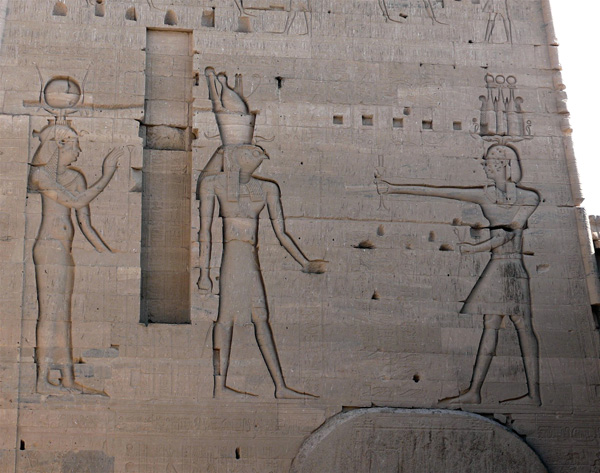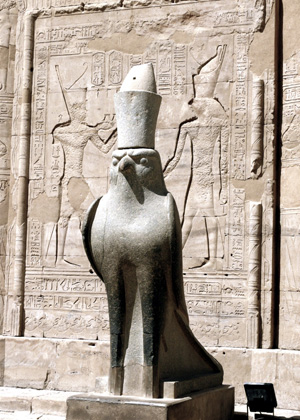ASWAN, EGYPT - We dart across the gangplank and through the reception area of our Sonesta cruise ship looking for the main lounge.
Our rush is not because the ship is about to sail - the Nile cruise ships leave Aswan en route to Luxor late each night - but we don't want to miss the nightly belly dance show.
No sooner are we seated and a server delivers glasses of Egyptian wine (a surprisingly bold vintage with hints of Coca-Cola and cough medicine) when the voluptuous Sheba makes her appearance.
The middle-aged woman starts gyrating her ample hips and torso to the sound of traditional belly dance music. Soon she urges me to join her on stage. A few other male patrons cannot resist Sheba's sultry advances, and within minutes the attractive Sheba is surrounded by a troupe of out of shape and out of step male tourists.
Our cruise on the River Nile is getting off on the right foot.
A Nile cruise is one of the highlights of a visitor's stay in Egypt. The slow-moving barge-like ships sail history's most important body of water at a pace which allows passengers a chance to absorb the many wonders that line its banks.


Above: Egypt's greatest temples can be found along the Nile.
The Sonesta Cruise Line ships - ours was the Sun Goddess - are flat-top and flat-bottom boats featuring top-deck swimming pools, spacious cabins, well-appointed public areas, an excellent selection of food and well-trained crew who are only too happy to explain the many wonders slowly floating past.
Sonesta is just one of many cruise companies offering Nile trips - every day over 100 ships, stacked three deep, line Aswan's dock waiting to take anxious passengers to the many temples built along the river to honour Egypt's ancient gods. The ships end up in Luxor, where the mother lode of temples is located.
Although sold as a three-day cruise, you actually spend only one day sailing the river. The first day is spent in Aswan boarding the ship, storing your gear and then quickly disembarking for a coach trip to see the nearby Temple of Philae, an amazing site built to honour the goddess Isis, mother of the Falcon God Horus.
Philae is one of the best preserved temples along the Nile but was lost for a while when the first Aswan dam was built as part of the country's massive hydro electric project. The temple was actually submerged beneath the flood waters in 1906 but in the 1970s, a new island, Egilika, was built and the temple was moved to the place we're headed to aboard the small motor craft we board at a nearby fishing village.
Philae is actually the first chapter in a story of revenge, which saw Horus pursue the killer of his father - the killer just happened to be Horus' uncle - at various places along the Nile.


Left: Nile temples tell Egypt's history. Right: Story of the Falcon God Horus is played out on the Nile.
The ruins of Philae are remarkable and the site was occupied by many over the centuries, including Roman legions and Napoleon's army. The latter left their calling cards - French graffiti is carved into the sandstone walls of the temple.
We spend most of the day exploring the reliefs and columns at Philae and as the sun sets, the island and the sandstone temple are cast in an orange glow. A beautiful site as we head back to the Sun Goddess.Back on board the ship, we enjoy a remarkable dinner and some Nubian folk music before retiring to our suite, where the gentle waves lapping the vessel lull us to sleep.
Just before dawn, the Sun Goddess sets sail from Aswan and two hours later a voice on the intercom awakens us with the news that we're about to dock at Komombo Temple, once home to Sobek, the crocodile god, and where the second chapter in the story of Horus is played out.
Despite the early hour, local merchants greet us with pleas to buy their crafts. The temple is a short walk from the dock and although smaller than Philae, it's no less impressive.
A guide takes us on a tour of the temple and points to ancient surgical instruments carved into the sandstone walls - amazingly they look very much like the surgical instruments still being used today. The guide tells us that a hospital stood on the site and points to graffiti carved into courtyard stone by patients while waiting to see physicians.
We are allowed just a few hours to take in all Komombo has to offer because we must soon be back onboard for our cruise to Edfu, the third and final chapter in the mythical story of Horus.
The Sun Goddess leads a flotilla of cruise ships along the fabled Nile and we camp out on the top deck and watch palm groves, amber desert, emerald islands and granite outcroppings slowly disappear behind us. Farmers sitting atop mules tend their fields and we wonder if we've not floated back in time because the scene looks like it jumped out of an ancient painting.
After another delicious lunch, the captain announces we should gather our cameras for an afternoon tour of the Temple of Edfu, built during the Ptolemaic period to honour Horus. Edfu, located 60 kilometres north of Aswan, was a thriving city in ancient times but today little remains except the temple, which was discovered in the 1860s and remains the best preserved temple in all of Egypt.
Edfu contains a chapel dedicated to the Goddess Nut. Various walls depict scenes of the divine marriage of Hathor and Horus. A guide tells us the temple inscriptions were completed over a period of 180 years.Comparing temple notes with fellow passengers on the top deck of the ship later in the day, we all agree Edfu was our favourite.
"Don't be so fast to judge," says Mustaf, our delightful server. "The best temples are still to come." Mustaf was referring to the temples awaiting us in Luxor, the ancient capital of Egypt and home to the Valley of the Kings. The city, located in Upper Egypt, 721 kilometres south of Cairo, is known as the greatest open-air museum in the world.
The Sun Goddess gently cozies up to the dock at Luxor late in the afternoon and passengers stand ready at the rail - anxious to hop aboard some waiting horse-drawn buggies so they can get to Karnak and Luxor temples before sunset.
Mustaf advices we visit Karnak first, "because it is much bigger and besides, Luxor Temple looks magnificent at sunset."
Karnak holds the title of "largest temple in the world" and represents several generations of Egyptian rulers, spanning 1,300 years. The massive complex consists of three main temples and several smaller ones. The site is littered with dozens of gigantic columns, some of which still hold up what's left of the main temple roof. Even in its crumbled state, Karnak is one of the most impressive sites this well-travelled pilgrim has ever seen. A local guide tells us in the evenings the site is bathed in light as part of a show that traces the temple's history and the story of great pharaohs who once lived within its walls.
We're tempted to stay for the light and sound show but the afternoon light was beginning to fade and we remembered Mustaf's tip that Luxor Temple had to be seen at sunset to truly be appreciated.A walkway known as The Avenue of Sphinxes that once connected Karnak and Luxor Temple was long ago overtaken by squatters and brush but a massive effort is being made to bring the path back to its original glory so the temples can once again be joined.
For now, though, we must take a cab a short distance to the entrance of Luxor Temple, where one lone attendant is trying to handle an army of waiting tourists, all trying to enter the site before sunset, which is fast approaching.Although much smaller than Karnak, Luxor Temple quickly jumps to the top of our favourite's list of those we've seen on this Nile cruise. Considered the most spectacular temple in Upper Egypt by historians, the complex built by Amenhotep III has been home to some of history's most fascinating characters, including Ramses II, Merenpeteh, Seti I and Alexander the Great.
The temple has a large forecourt facing a massive pylon, across from which two obelisks once stood. One remains, the other now sits in Rome. Other features of the compact temple include two seated colossi of Ramses II, considered the greatest of Egypt's ancient rulers, and a shrine.
As the sun sets behind the temple, the walls are turned a brilliant orange and the natural light show has tourists snapping photographs at record pace.
We return to the Sun Goddess and prepare for our final excursion the next day to the Valley of the Kings.
Again, our evening is spent sipping drinks on the top deck and enjoying another belly dance show.

Above: Flat top cruise ships sail back in time on the Nile.
We're up bright and early the third and final day of our cruise - we will check out and head to the airport for our return flight to Cairo later in the day, but first we board a coach and head off to the Valley of the Kings, where most of Egypt's ancient rulers are buried in elaborate tombs carved into the valley's mountains.
The valley is the royal necropolis for more than 62 kings - 60 queens, princes and princesses are entombed in the nearby Valley of the Queens - and we are disappointed to find that cameras are not permitted on the site.
The tombs of Tutankhamen and Ramses II cost extra to visit but are well worth the price. The treasures found buried with some of the kings - most tombs were robbed by local villagers shortly after the royal burials - have been removed and are showcased at the Egyptian Museum in Cairo.
The largest collection of ancient Egyptian treasures and artifacts were discovered when Tutankhamen's tomb was uncovered. That, according to our guide, was because the tomb of the boy king was covered over by fill taken from tombs created for more important rulers. Tutankhamen, who died in his teens, was not considered as important as those from the Ramses dynasty.
The rest of our day is spent visiting Luxor's Museum of Mummification and the massive, three-tiered temple built for Queen Hatshepsut - one of the few Egyptian temples built with limestone instead of sandstone. Queen Hatshepsut was the only woman ever to become a pharaoh and the temple was built to commemorate her achievements, which included introducing Egyptian culture to the rest of the ancient world.
Our cruise journey to Upper Egypt complete, we bid Mustaf and other crew of the Sun Goddess goodbye and head for the airport as the sun casts long shadows on the Nile - a river which allows you to drift back in time.
Informaton
· Despite the recent uprisings in Egypt, much of it were contained to Cairo and Alexandria, the area around Luxor remains open for tourism and the Nile Cruise ships are still operating normally.
· The Canadian government recently lifted its travel advisory to the Luxor area in Egypt.
· Tour East Holidays offers tour packages to Egypt that include a Nile cruise. Go to www.toureast.com.